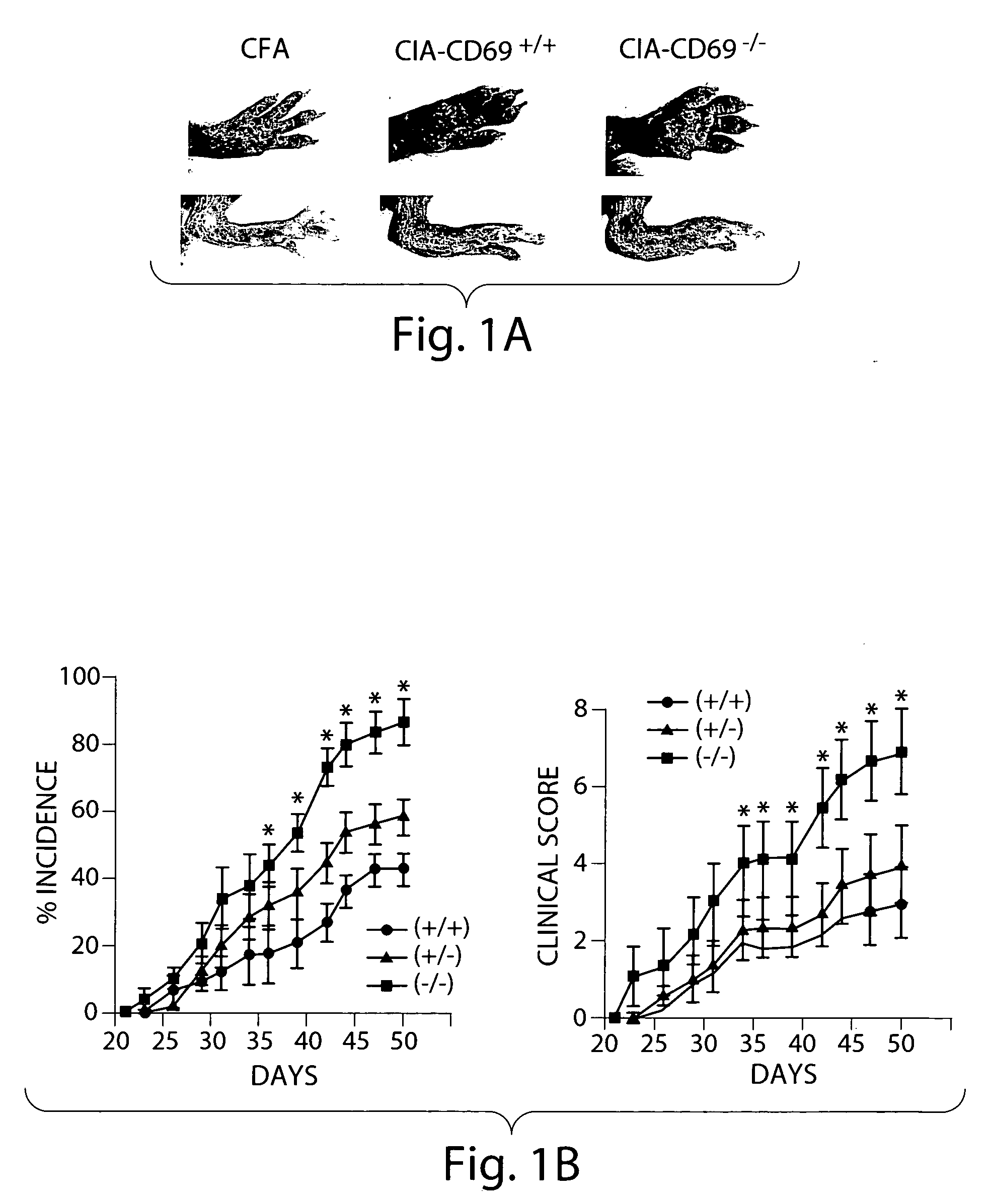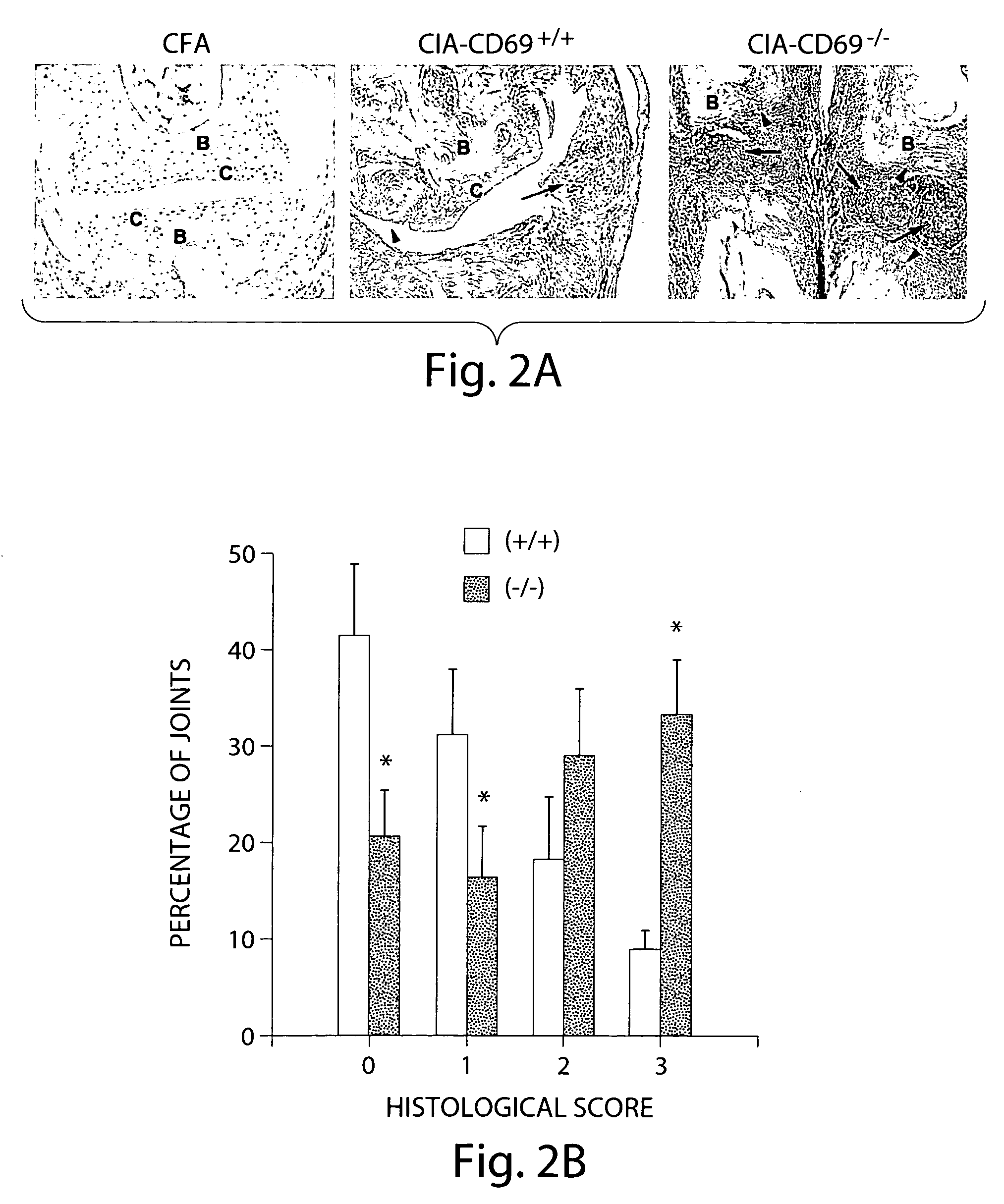Immune regulation based on the targeting of early activation molecules
a technology of early activation and immune regulation, applied in the direction of immunological disorders, metabolism disorders, therapy, etc., can solve the problems of reducing their efficacy and safety, and limiting human immunotherapeutic use, so as to suppress tumor growth and metastasis, enhance immune response, and low level
- Summary
- Abstract
- Description
- Claims
- Application Information
AI Technical Summary
Benefits of technology
Problems solved by technology
Method used
Image
Examples
example 1
CD69-Deficient Mice Develop an Exacerbated CIA
[0314] To explore the role of CD69 in a model of chronic autoimmune arthritis, interbred B6 WT and CD69− / − mice (Lauzurica et al., 2000) were compared for incidence and severity of CIA induced by intradermal immunization with CII in CFA, which elicits a moderate arthritis in B6 mice (Campbell et al., 2000). CD69-deficient mice developed an exacerbated form of CIA, with severe swelling of the footpad, ankle / wrist joints and digits (FIG. 1a), and significantly higher incidence and severity compared to WT mice (FIG. 1b). Furthermore, CD69+ / − mice, which express intermediate levels of CD69 (Lauzurica et al., 2000), showed a higher incidence and severity of CIA than WT mice, but significantly lower than CD69− / − mice (FIG. 1b).
[0315] To further evaluate arthritis, hematoxylin and eosin-stained sections of paws from CD69− / − and WT mice with different grades of CIA were assessed by histological analyses. These studies paralleled the results sh...
example 2
Enhanced Collagen type II-Specific Immune Response in CD69− / − Mice.
[0316] These results strongly suggested that CII triggers exacerbated immune response in CD69− / − mice. Accordingly, the spleen was significantly enlarged in CD69− / − CII-challenged mice (about 1.4 fold heavier, p− / − mice either in the absence of any stimulation or after CII challenge (not shown).
[0317] To assess lymphocytes reactivity, the CII-specific proliferative response of lymphocytes from spleen and lymph nodes were analyzed. Lymphocytes from CD69− / − mice proliferated to a significantly higher extent than WT mice at the different doses of CII tested (FIG. 3C), indicating an inhibitory influence of CD69 in the CII-specific proliferation of immune cells form CII-challenged mice.
[0318] The humoral response to CII was also investigated. Analysis of serum concentration of anti-CII isotypes showed significantly augmented levels of the Th1-dependent isotypes IgG2c, which is equivalent in B6 mice to IgG2a, and IgG2b ...
example 3
CD69-Deficient Mice show a Diminished Local TGF-β1 Production.
[0319] A wide array of cytokines are involved in inflammation and development of arthritis (O'Shea, J. J., et al. 2002. Nat. Rev. Immunol. 2:37-45; Feldmann, M., et al. 1996. Ann. Rev. Immunol. 14:397-440.Campbell, I. K., et al. 2001. J. Clin. Invest. 107:1519-27.). Since the joints are the most relevant site of cytokine production in arthritis, we tested how CD69 deficiency could affect the profile of cytokine expression in joints of mice with CIA. Rnase protection assays showed that CD69 deficiency enhances mRNA expression of some inflammatory mediators such as IL-1β, RANTES, MIP-1χ, and MIP-1β (FIG. 4). However, the most significant difference was the reduction in mRNA levels of the anti-inflammatory cytokines TGF-β and β2 in CD69− / − mice (FIG. 4). Real time quantitative RT-PCR analyses confirmed the reduction in joint mRNA for TGF-β1 and β2, and the increase in IL-1β and RANTES (FIG. 5A).
[0320] Next, the levels of a...
PUM
| Property | Measurement | Unit |
|---|---|---|
| temperature | aaaaa | aaaaa |
| concentration | aaaaa | aaaaa |
| TGF-α production | aaaaa | aaaaa |
Abstract
Description
Claims
Application Information
 Login to View More
Login to View More - R&D
- Intellectual Property
- Life Sciences
- Materials
- Tech Scout
- Unparalleled Data Quality
- Higher Quality Content
- 60% Fewer Hallucinations
Browse by: Latest US Patents, China's latest patents, Technical Efficacy Thesaurus, Application Domain, Technology Topic, Popular Technical Reports.
© 2025 PatSnap. All rights reserved.Legal|Privacy policy|Modern Slavery Act Transparency Statement|Sitemap|About US| Contact US: help@patsnap.com



